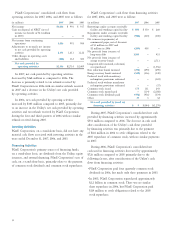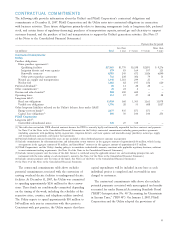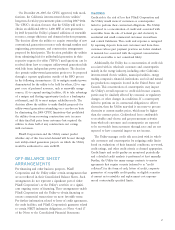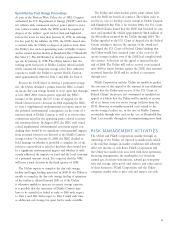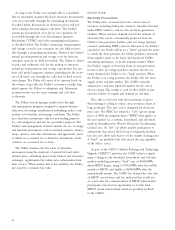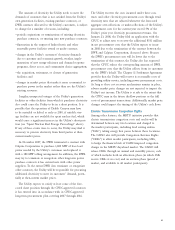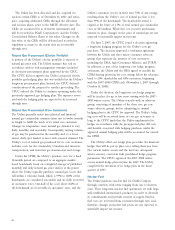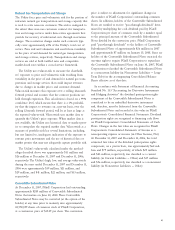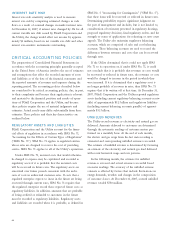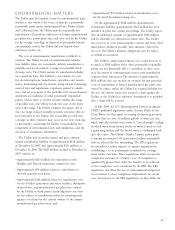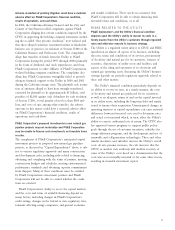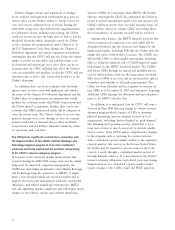PG&E 2007 Annual Report Download - page 64
Download and view the complete annual report
Please find page 64 of the 2007 PG&E annual report below. You can navigate through the pages in the report by either clicking on the pages listed below, or by using the keyword search tool below to find specific information within the annual report.62
The Utility has been allocated and has acquired via
auction certain CRRs as of December 31, 2007 and antici-
pates acquiring additional CRRs through the allocation
and auction phases prior to the MRTU effective date. The
CRRs are accounted for as derivative instruments and
will be recorded in PG&E Corporation’s and the Utility’s
Consolidated Balance Sheets at fair value. Changes in the
fair value of the CRRs will be deferred and recorded in
regulatory accounts to the extent they are recoverable
through rates.
Natural Gas Procurement (Electric Portfolio)
A portion of the Utility’s electric portfolio is exposed to
natural gas price risk. The Utility manages this risk in
accordance with its risk management strategies included
in electricity procurement plans approved by the CPUC.
The CPUC did not approve the Utility’s proposed electric
portfolio gas hedging plan that was included in the Utility’s
long-term procurement plan. Instead, the CPUC deferred
consideration of the proposal to another proceeding. The
CPUC ordered the Utility to continue operating under the
previously approved gas hedging plan. The expenses associ-
ated with the hedging plan are expected to be recovered
through rates.
Natural Gas Procurement (Core Customers)
The Utility generally enters into physical and fi nancial
natural gas commodity contracts from one to twelve months
in length to fulfi ll the needs of its retail core customers.
Changes in temperature cause natural gas demand to vary
daily, monthly, and seasonally. Consequently, varying volumes
of gas may be purchased in the monthly and, to a lesser
extent, daily spot market to meet such seasonal demand. The
Utility’s cost of natural gas purchased for its core customers
includes costs for the commodity, Canadian and interstate
transportation, and intrastate gas transmission and storage.
Under the CPIM, the Utility’s purchase costs for a fi xed
12-month period are compared to an aggregate market-
based benchmark based on a weighted average of published
monthly and daily natural gas price indices at the points
where the Utility typically purchases natural gas. Costs that
fall within a tolerance band, which is 99% to 102% of the
benchmark, are considered reasonable and are fully recovered
in customers’ rates. One-half of the costs above 102% of
the benchmark are recoverable in customers’ rates, and the
Utility’s customers receive in their rates 75% of any savings
resulting from the Utility’s cost of natural gas that is less
than 99% of the benchmark. The shareholder award is
capped at the lower of 1.5% of total natural gas commodity
costs or $25 million. While this cost recovery mechanism
remains in place, changes in the price of natural gas are not
expected to materially impact net income.
On June 7, 2007, the CPUC issued a decision approving
a long-term hedging program for the Utility’s core gas
purchases. The decision approved a settlement agreement
between the Utility and three major consumer advocate
groups that represent the interests of core customers,
including the DRA, Aglet Consumer Alliance, and TURN.
In addition, as part of the long-term core hedge program
settlement, the Utility and the DRA agreed to modify the
CPIM sharing provision for cost savings below the tolerance
band to 20% shareholder and 80% customers, beginning
with the 2007–2008 CPIM cycle (November 1, 2007 through
October 31, 2008).
Under the decision, the long-term core hedge program
will be in place for up to fi ve years starting with the 2007–
2008 winter season. The Utility consults with an advisory
group, consisting of members of the three core gas con-
sumer advocate groups, before submitting its annual
hedging plan to the CPUC for approval. The Utility’s hedg-
ing costs will be recovered from its core gas customers as
long as the CPUC fi nds that the Utility implemented its
hedges in accordance with the pre-approved plan. All costs
and benefi ts associated with hedging purchases under the
approved annual hedging plan will be accounted for outside
the CPIM.
The Utility’s fi led core hedge plan prescribes the fi nancial
hedges that will be put in place on a rolling three-year basis
(the current winter season and the next two subsequent
winter seasons), consistent with pre-defi ned hedge program
parameters. The CPUC approved the 2007–2008 winter
season annual hedge plan on June 26, 2007. The Utility
completed the execution of its hedge plan in the third
quarter of 2007.
Nuclear Fuel
The Utility purchases nuclear fuel for Diablo Canyon
through contracts with terms ranging from one to thirteen
years. These long-term nuclear fuel agreements are with large,
well-established international producers in order to diversify
its commitments and provide security of supply. Nuclear
fuel costs are recovered from customers through rates and,
therefore, changes in nuclear fuel prices are not expected to
materially impact net income.


